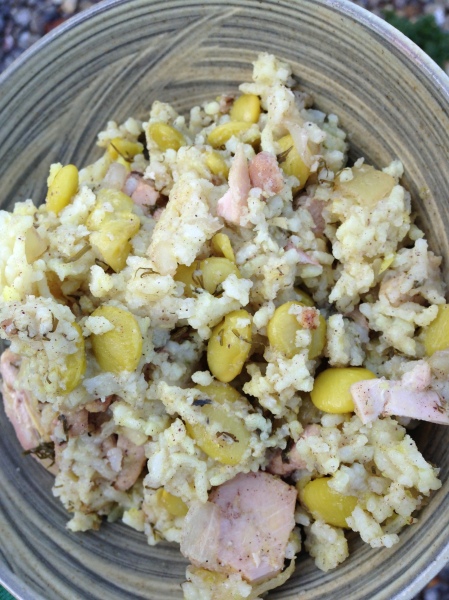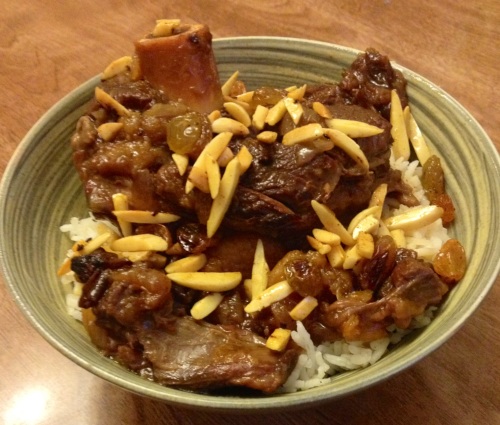I grew up eating rice only occasionally, and when my mother did make it, it was simple: one cup of rice with one cup of water, with half of a jalapeno thrown in. It was so unmemorable that I don’t even remember what we usually ate it with. I was exposed to your standard beans and rice, the rice that comes on the side of Mexican food, but it wasn’t until I moved to Washington, D.C., that I started to discover the magic of Persian and Afghani polows, Cuban Moros y Cristianos, and the delight of Teaism’s coconut rice pudding.
In the Middle East, rice often holds near mystical rank on the dinner table, where it can come as a simple staple, mounded around a whole roasted lamb, or jeweled with nuts, dried fruit, herbs and meat. Nearly every dish has a traditional rice side it is served with. A delicious Egyptian lunch of fried fish would not be complete without a side of rice prepared with onions and tomato paste.
In Iraq, rice can be an emotional subject. When you talk to Iraqi expatriates and refugees and about their home, the topic of Iraq’s aromatic, unique and sadly disappearing rice might come up. Ethnic strife, repeated wars, water politics and environmental degradation have combined to decimate Iraq’s agricultural production, forcing Iraqis to import rice from countries such as India, China and the United States. However, Iraqis never stop longing for the aromatic allure of Amber rice, grown in small quantities in the country’s south. Those from Mosul might speak of the large, dark grains of Naggaza rice, produced in the north.
My favorite Iraqi rice dish is Timman Bagila, or fava bean rice. Whenever I see fresh fava beans and dill at the farmers market I want to make this, though I rarely see them both at the same time. While living in Lebanon, I wrote a blog post featuring my own Timman Bagila recipe using lamb shanks. This dish is a bit of a process, but none of the steps are complicated or difficult. While not as traditional, using chicken thighs produces a bit lighter but just as tasty meal!
Timman Bagila with Chicken
1 12-ounce bag frozen fava beans (lima beans work too!)
pinch turmeric
2 pounds boneless chicken thighs
olive oil
salt
pepper
2 cups basmati rice, rinsed and soaked in cold water (at least an hour)
1 medium white onion, diced
2 teaspoons ground cinnamon
3 cloves garlic, minced
1 cup finely chopped fresh dill
1 lemon
2 cups hot chicken broth
toasted pine nuts or almonds (optional)
Serves 4-6.
1. Turn on your broiler, and position a rack about 8 inches below.
2. Bring a medium pot to a boil and cook fava beans with a pinch of turmeric, until the beans are soft enough to chew but not mushy. Drain the beans and set aside. Rinse out the pot — you can use it again to assemble and finish the dish.
3. Place the chicken thighs on a baking sheet and rub with olive oil and season with salt and pepper. When your broiler and oven are warm, place thighs in the oven for 12-15 minutes until cooked, turning them over about half way though. Remove from the oven and set aside.
4. While your chicken is cooking, heat a medium pot over medium heat and add drained rice, a tablespoon of salt and a pinch of turmeric. Pour in water to cover by half an inch, stir the pot, and bring to a boil. Cover the pot, and turn the heat to low. Cook for approximately 15 minutes, or until the rice has softened and most of the water is absorbed.
4. When you pull the chicken out of the oven, heat a large pan over medium heat with a tablespoon of olive oil. Add onions and a pinch of salt and sauté until translucent. Add 2 teaspoons of cinnamon and minced garlic, and stir to combine. Roughly chop the chicken, and add to the pan along with the lightly cooked fava beans and the chopped dill. Squeeze the lemon juice over the mixture, stir to combine, and cook for for 2-3 minutes, and turn off the heat. This is a good time to heat up your 2 cups of chicken broth- you can throw it in the microwave or heat it up on the stove.
5. Place the medium pot you rinsed and set aside earlier over medium-high heat, and add 2 tablespoons of olive oil. Let heat for about a minute, and evenly spread a scoop of your parboiled rice in the pot- you want enough rice to cover the bottom. Let the rice cook for about 30 seconds- you are hoping this turns into a crust when the dish is done!
6. Add a scoop of your chicken/dill/fava bean mixture, followed by another scoop of rice, and then another scoop of your chicken mix. You want to form these layers into a bit of a pyramid- don’t smooth it out or pack the layers together. Continue this layering until you are out. With the back of your spoon make 4-5 tunnels down into the bottom of the rice layers, and pour in your hot chicken broth. When the liquid starts to bubble, cover the pot and turn the heat to low. After 20 minutes, check to see that the rice has absorbed the liquid and is cooked- if not, put the lid back on for 5 minutes and check again.
7. When you are ready to serve the dish, scoop it out onto a platter. Scrape out the pieces of crust on bottom and arrange on top of the rice. If you can’t get the crust out, fill your sink with a bit of cold water and hold the bottom of the pot in the water to help loosen the crust. I like to garnish the dish with some toasted pine nuts or almond slivers.




